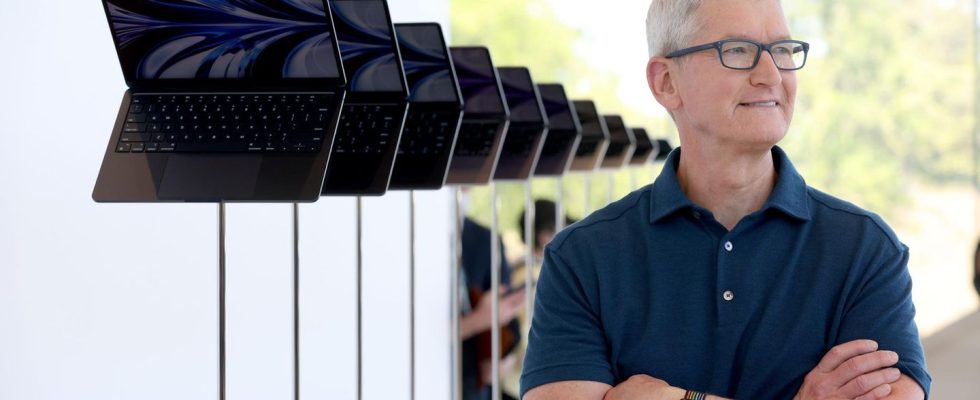iPhone manufacturer
Rising profits with falling revenues: Tim Cook’s Apple strategy is paying off
Apple boss Tim Cook next to the new models of the Macbook Air. On the stage of the WWDC keynote, Cook reserved a distinguished manner.
© Justin Sullivan / AFP
Apple has been working for years to become more independent of the iPhone. Now the strategy is paying off. The iPhone is currently not the problem child.
These are numbers that other company bosses would lick their fingers after: Apple earned $89.5 billion – in just three months. That boss Tim Cook has to justify this for a simple reason: revenue has fallen compared to the previous year. But profits went up. Because Cook has been setting the company on a new course for years.
It was actually supposed to cushion the slump in the smartphone market. As early as 2015, it became apparent for the first time that sales of the iPhone could slowly decline. This was a threatening scenario for Apple: at its peak, the company earned almost 70 percent of its sales from its top product. In 2017, Cook therefore set a highly ambitious goal: by 2020, they wanted to double revenue from the service area to almost $50 billion a year. Now this decision saves his profits.
With services from the smartphone depths
The service division, which includes not only the App Store but also subscription offers such as the streaming services Apple Music or Apple TV+ as well as the cloud business, is not only one of the biggest success stories of the already enormously successful group. But it has also long been one of the biggest profit makers.
The fact that the service division accounts for almost a quarter of revenue at $22.3 billion is impressive. But even more important is that it brings almost 40 percent of the group’s profits into the coffers. And thus ensures an increase in profits despite reduced sales.
Premium strategy
Actually, the quarter would have been rather unpleasant for Cook and his team. For the fourth time in a row, quarterly sales are below those of the previous year. This hasn’t happened in more than 20 years. But it’s not just the iPhone that’s to blame. Calculated over 12 months, all divisions of the group have declined except for the service area. Only in the most recent quarter was the iPhone 15, introduced in September, able to increase sales again. “The iPhone 15 performed better than the iPhone 14 during this period,” said Tim Cook to CNBC.
Here too, Cook’s foresight should pay off. While Apple previously gave specific sales figures for iPhones, for several years now it has only revealed the income generated from them. This is related to another change in strategy: Instead of selling customers as many iPhones as possible, Apple has focused in recent years on increasing the average price per device sold.
The Pro models play a crucial role here. While there was initially only a single iPhone model, Apple now offers five current models with different features and at different price points. The differences are becoming more and more pronounced. If you really want the most modern device with a titanium housing and a five-fold zoom, you have to buy the iPhone 15 Pro Max (tested here) – and pay at least 1,449 euros for it. According to Cook, many customers seem to be willing to do this: the demand for the Pro models of the iPhone 15 is so great that production cannot currently be kept up, he emphasized to several media outlets.
iMac and Macbook Pro
Apple’s new launches in pictures: The new Macs are so chic
The Mac as a problem child
The company’s current problem child is the division that was only recently able to celebrate a huge comeback: the Mac. In 2020, Apple took its classic computers to the next level at the perfect time. Just as working from home reached its peak during the pandemic, Apple introduced its M1 chip, a processor that was able to combine enormous performance with impressive battery life. Mac sales skyrocketed.
Now the hangover follows. Compared to the strong previous year, Apple’s revenue from the Mac fell by more than a third in the last quarter, leaving a hole of almost four billion dollars in Apple’s total sales. Without the compensation from the increased service business, profits would have declined in the last quarter – as was the case for the entire year.

Hope for Christmas business
The lack of success of the current Macs also explains the surprisingly quick introduction of the successor models. When Apple introduced its new Macbook Pro with M3 chip on Monday evening (local time) (you can find out more here), the predecessors had not even been on the market for a year: they had only gone on sale in January. With the quick new launch, Apple certainly wanted to boost the important Christmas business.
However, gigantic growth is apparently not expected. The market remains “challenging,” emphasized Cook. Nevertheless, the group is well positioned with the new computers. However, the target group does not seem to be customers who have just bought a Mac. When the new devices were introduced, it was emphasized several times how much faster they were than older Macs.
However, further growth seems to be expected in services. “Each of the major services is seeing record revenue,” Cook said. The division is only likely to become more important in the future.


